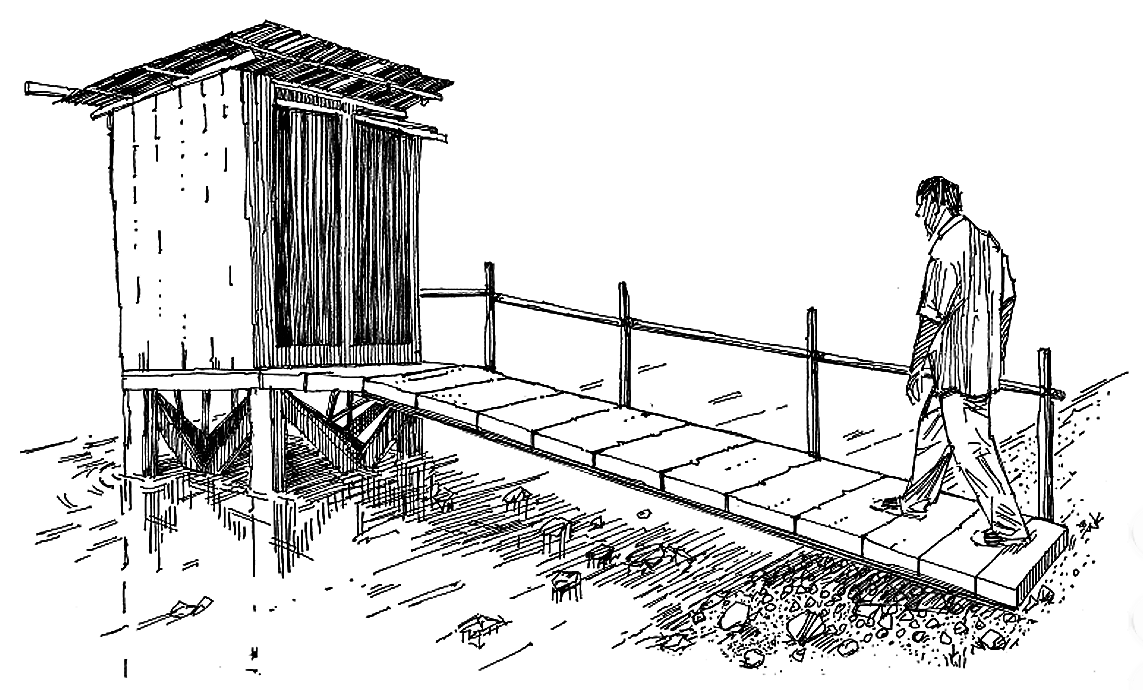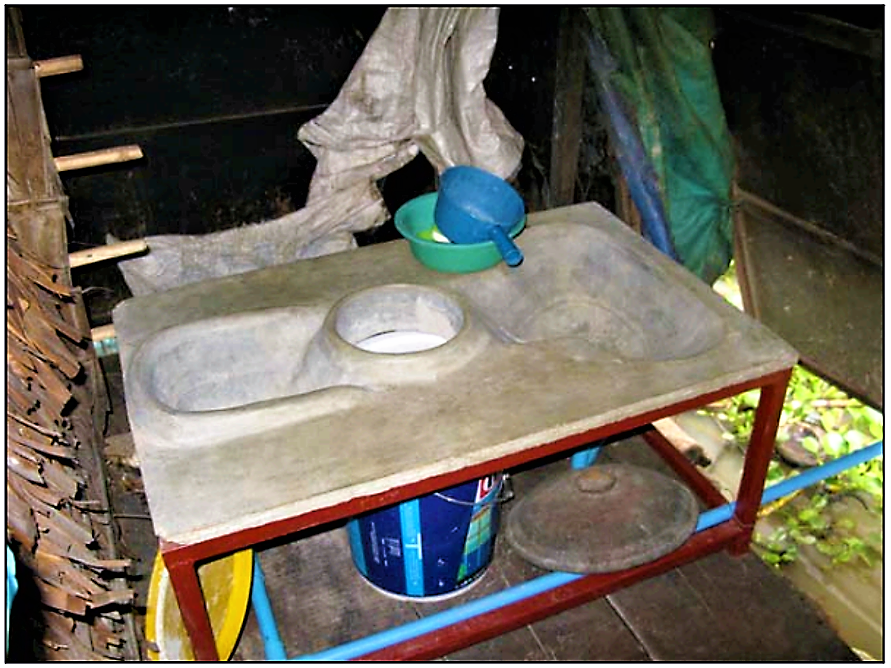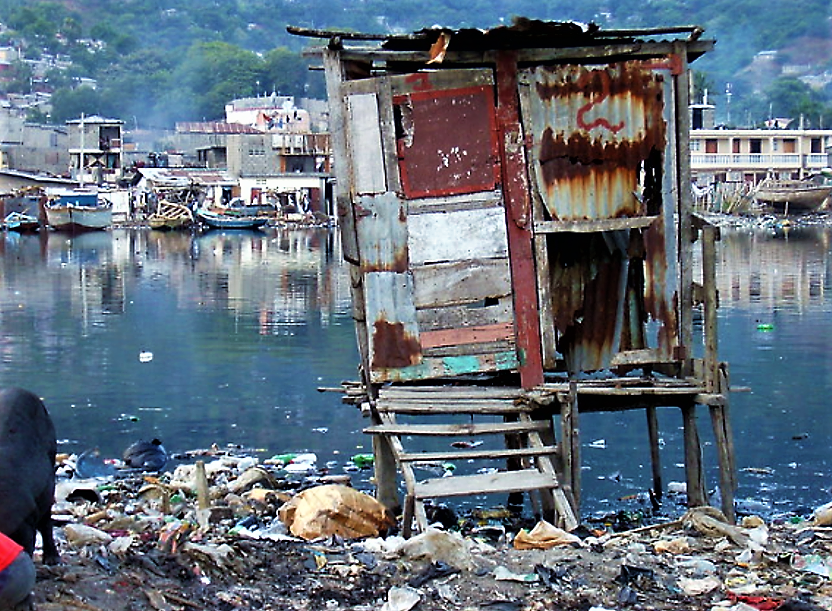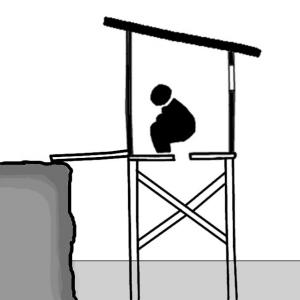Executive Summary
An overhung latrine consists of a superstructure and floor built over water. A squat hole in the floor allows excreta to fall directly into the water below. Overhung latrines are rarely appropriate (due to the direct pollution of water) and should only be considered if other options are not possible. The receiving water must be sufficiently deep throughout the year, should preferably be saline to prevent human consumption and should be flowing away from settlements. Over all, this is a very cheap solution, can be built with locally available material and is easy to operate and maintain. However, if there is any chance to built a other toilet with less hazard for the receiving water body (e.g. UDDT or composting toilet), overhung latrines should be avoided.
| In | Out |
|---|---|
Urine or Yellowwater, Faeces, Excreta |
Basic Design Principles
An overhung latrine consists of a superstructure, which should be mechanically sturdy and safe for users, a latrine floor built on top of a wood, concrete, metal, or pole structure above water and situated along side banks of water or coastal flats. A squat hole in the floor allows excreta to fall directly or via a chute, into the water below (FARIS et al. 2002; HARVEY et al. 2002). The overhung latrine is a very basic system, and it should only be considered if other options are impossible (HARVEY et al. 2002).

In areas where this type of installation is used, the contamination of the surface water (river, lake or other) is inevitable and it is a big challenge for affected communities to organise uncontaminated fresh water. Usually, they have to get fresh and drinking water from local vendors or need to walk big distances to a water source, e.g. a well (see human powered distribution). There might be tank trucks that bring water to the settlements. This generates high costs and not every government is willing or able to cover them. Otherwise, they may be forced to use contaminated water. To make the use of overhung latrines as safe as possible, the following criteria should be considered (FARIS et al 2002; HARVEY et al. 2002):
- The receiving water should be of a saline nature all year-round so that people are discouraged to use it for drinking.
- The receiving water must be deep enough throughout the year and should be flowing away from the settlement.
- The latrine is installed over such water depth that the water bed is never exposed during the dry season.
- Every effort should be made to select a site that would provide the transfer of floating materials and assist with dilution.

Regardless, recommendation for such type of latrine is only for those areas where conventional terrestrial types such as pit latrines cannot be built. In areas where water contact as means of seeking livelihood (e.g. fishing), transport or recreation/ bathing is a way of life, the system is never recommended (FARIS et al. 2002).
A solution to improve the sanitation problem in floating communities or dense settlements close to surface water bodies could be the concept of the floating latrine, which is described by BROWN et al. (2010). It is a similar concept like the UDDT system, but designed to install above water bodies such as rivers or lakes. Another solution for coastal areas is a hanging UDDT which is described by GENSCH et al. (2010).
Cost Considerations
The overhung latrine is a very cheap solution. It can be built with local material (wood, concrete, bamboo, metal, etc.). However, not everyone has access to an appropriate space to build an overhung toilet and people downstream and the environment have to pay a very high “price” for the damages which this solution creates.

Operation and Maintenance
Apart from keeping it clean, there is no daily maintenance. It is easy to operate and compared to a simple pit latrine there are no emptying activities since the river carries the excreta away. So the faecal waste can neither be disposed of properly nor can the nutrients be reused (e.g. use of compost). To guarantee the safety of the users, the supporting parts of the superstructure need to be replaced regularly (UNDP 2005).
Health Aspects
Overhung latrines are used extensively in all urban slums located near surface water bodies such as rivers and lakes (UNDP 2005). The water body cannot decompose all this faecal waste thus leading to heavy contamination of the surface water sources (such as lakes, rivers or the coastal zones of the sea). Therefore local communities should be warned of the danger to health resulting from contact with or use of water into which excreta has been discharged (WHO 1992). Furthermore, there is a risk of coming into direct contact with the faecal water below the toilet when users fall into the water (e.g. bad construction of the superstructure) or when children play close to the water source.
At a Glance
| Working Principle | Overhung latrines consist of a superstructure and a latrine floor built on top of a wood, concrete or metal frame or pole structure above water alongside banks of water or coastal flats. A squat hole in the floor allows excreta to fall directly into the water below. |
| Capacity/Adequacy | An overhung latrine is designed for areas where there is a constant water body, which is able to transport the excreta away. It is relatively simple to build and can be constructed by the users themselves with locally available material. |
| Performance | There is no treatment process causing contamination of the receiving water body. |
| Costs | Very low. |
| Self-help Compatibility | Can be built and repaired with locally available material. It must be maintained correctly and well-kept. |
| O&M | Apart from keeping it clean, there is no daily maintenance associated. |
| Reliability | People, especially women, have a protected place to utilise a toilet. |
| Main strength | Protected place to do daily sanitation. Low maintenance required. |
| Main weakness | Leads to heavy water pollution. |
In scarcely populated areas with a constant and large fresh water body, the system can in some circumstances be adapted. But in slums where people live in water logged areas or close to rivers, the use of overhung toilets becomes a serious hazard for the water bodies and thus the health of the surrounding people.If there is any chance to build a different toilet system (e.g. UDDT or composting toilet), overhung latrines should be avoided.
Sanitation in Floating Communities in Cambodia
This project is focused on developing an innovative sanitation solution that is affordable for implementation within floating communities on the Tonle Sap in Cambodia.
BROWN, M. SODANEATH, H. SMITH, J. HAGAN, J. BUNTHAN, K. (2010): Sanitation in Floating Communities in Cambodia. Phnom Penh and Melbourne: Live and Learn Environmental Education and Engineers without Borders URL [Accessed: 05.10.2011]Human and other Liquid Waste Management
This lecture note, which is specifically prepared for the diploma level environmental health students, addresses the problem of human waste disposal or management. Different appropriate latrine technologies and on-site wastewater containment and treatment facilities are listed; their construction methods and the advantages/ disadvantages of each are included.
FARIS, K. ALEMAYEHU, T. WUBSHET, M. HAILU, D. (2002): Human and other Liquid Waste Management. Jimma and Atlanta: Jimma University URL [Accessed: 31.05.2019]Low-Cost Sustainable Sanitation Solutions for Mindanao and the Philippines. A Practical Construction Field Guide
After a brief introductory chapter on the Philippine sanitation situation and basic principles of sustainable sanitation, the manual focuses on the introduction of different low-cost sanitation solutions comprising the arborloo toilet, the 1-chamber and 2-chamber UDDT, hanging UDDTs, and the ecopee urinal. Each technology is briefly described by giving general information on how it works, operation and maintenance requirements, reuse or safe disposal options, and in which setting this technology might be appropriate. In addition, a picture-based guide on how to construct each technology is provided as well as the necessary technical drawings and rough cost estimates based on current prices. Since a sanitation system does not end with the toilet itself, the last chapter also provides information on the overall management of the system including collection, transport, treatment, and final reuse of urine, feces and composting products in agriculture.
GENSCH, R. MISO, A. ITCHON, G. SAYRE, E. (2010): Low-Cost Sustainable Sanitation Solutions for Mindanao and the Philippines. A Practical Construction Field Guide. Cagayan de Oro City: Xavier University URL [Accessed: 31.05.2019]Emergency Sanitation: Assessment and Programme Design
This book has been written to help all those involved in planning and implementing emergency sanitation programmes. The main focus is a systematic and structured approach to assessment and programme design. There is a strong emphasis on socio-cultural issues and community participation throughout.Includes an extensive “guidelines” section with rapid assessment instructions and details on programme design, planning and implementation.
HARVEY, P. BAGHRI, S. REED, B. (2002): Emergency Sanitation: Assessment and Programme Design. Loughborough: Water, Engineering and Development Centre (WEDC) URL [Accessed: 31.05.2019]Sanitation for You and Me – A Post-Tsunami Technical Overview
This manual looks at the broader issues of sanitation, handling of waste, and then examines the sanitation issue and provides some technical detail on construction and design.
UNDP (2005): Sanitation for You and Me – A Post-Tsunami Technical Overview. New Dehli: United Nations Development Program (UNDP) URL [Accessed: 31.05.2019]A Guide to the Development of On-site Sanitation
The publication presents appropriate technologies for sanitation and highlights socio-economic aspects of planning and implementing. Emphasis is given to household-level sanitation improvements for urban areas, as well as rural areas and small communities. Background information on sanitation, in-depth technical information on the design, construction, operation and maintenance and project planning and development processes involved in projects and programmes complement the book.
WHO (1992): A Guide to the Development of On-site Sanitation. Geneva: World Health Organisation (WHO) URL [Accessed: 14.04.2010]Technical Options for Excreta Disposal in Emergencies
This technical note outlines ways in which excreta and urine can be managed during the early stages of an emergency, while long-term solutions are devised and implemented.
WHO (2011): Technical Options for Excreta Disposal in Emergencies. Geneva: World Health Organization (WHO) URL [Accessed: 29.09.2011]Sanitation Solutions for Flooded Zones
This publication discusses WAND’s experience in promoting ecological sanitation in flooded zones where pour-flush toilets are no longer effective and where people defecate in the open. In this project, promoting a decentralized sanitation system that is cheap, robust, appropriate, and scalable is possible.
SAYRE, E.V. SAYRE, J.C. (2011): Sanitation Solutions for Flooded Zones. The WAND Foundation Experience. London: Water, Agroforestry, Nutrition and Development Foundation (WAND) Inc URL [Accessed: 31.05.2019]Human and other Liquid Waste Management
This lecture note, which is specifically prepared for the diploma level environmental health students, addresses the problem of human waste disposal or management. Different appropriate latrine technologies and on-site wastewater containment and treatment facilities are listed; their construction methods and the advantages/ disadvantages of each are included.
FARIS, K. ALEMAYEHU, T. WUBSHET, M. HAILU, D. (2002): Human and other Liquid Waste Management. Jimma and Atlanta: Jimma University URL [Accessed: 31.05.2019]Emergency Sanitation: Assessment and Programme Design
This book has been written to help all those involved in planning and implementing emergency sanitation programmes. The main focus is a systematic and structured approach to assessment and programme design. There is a strong emphasis on socio-cultural issues and community participation throughout.Includes an extensive “guidelines” section with rapid assessment instructions and details on programme design, planning and implementation.
HARVEY, P. BAGHRI, S. REED, B. (2002): Emergency Sanitation: Assessment and Programme Design. Loughborough: Water, Engineering and Development Centre (WEDC) URL [Accessed: 31.05.2019]Sanitation for You and Me – A Post-Tsunami Technical Overview
This manual looks at the broader issues of sanitation, handling of waste, and then examines the sanitation issue and provides some technical detail on construction and design.
UNDP (2005): Sanitation for You and Me – A Post-Tsunami Technical Overview. New Dehli: United Nations Development Program (UNDP) URL [Accessed: 31.05.2019]A Guide to the Development of On-site Sanitation
The publication presents appropriate technologies for sanitation and highlights socio-economic aspects of planning and implementing. Emphasis is given to household-level sanitation improvements for urban areas, as well as rural areas and small communities. Background information on sanitation, in-depth technical information on the design, construction, operation and maintenance and project planning and development processes involved in projects and programmes complement the book.
WHO (1992): A Guide to the Development of On-site Sanitation. Geneva: World Health Organisation (WHO) URL [Accessed: 14.04.2010]Technical Options for Excreta Disposal in Emergencies. Technical Notes on Drinking-Water, Sanitation and Hygiene in Emergencies
Initially, indiscriminate defecation is usually the main health hazard in refugee camps. This technical note outlines ways in which excreta and urine can be managed during the early stages of an emergency, while long-term solutions are devised.
REED, B. (2013): Technical Options for Excreta Disposal in Emergencies. Technical Notes on Drinking-Water, Sanitation and Hygiene in Emergencies. (= Technical Notes on Drinking-Water, Sanitation and Hygiene in Emergencies , 14 ). Geneva: World Health Organization (WHO) URL [Accessed: 01.10.2013]Low-Cost Sustainable Sanitation Solutions for Mindanao and the Philippines. A Practical Construction Field Guide
After a brief introductory chapter on the Philippine sanitation situation and basic principles of sustainable sanitation, the manual focuses on the introduction of different low-cost sanitation solutions comprising the arborloo toilet, the 1-chamber and 2-chamber UDDT, hanging UDDTs, and the ecopee urinal. Each technology is briefly described by giving general information on how it works, operation and maintenance requirements, reuse or safe disposal options, and in which setting this technology might be appropriate. In addition, a picture-based guide on how to construct each technology is provided as well as the necessary technical drawings and rough cost estimates based on current prices. Since a sanitation system does not end with the toilet itself, the last chapter also provides information on the overall management of the system including collection, transport, treatment, and final reuse of urine, feces and composting products in agriculture.
GENSCH, R. MISO, A. ITCHON, G. SAYRE, E. (2010): Low-Cost Sustainable Sanitation Solutions for Mindanao and the Philippines. A Practical Construction Field Guide. Cagayan de Oro City: Xavier University URL [Accessed: 31.05.2019]Sick Water? The central role of wastewater management in sustainable development
This book not only identifies the threats to human and ecological health that water pollution has and highlights the consequences of inaction, but also presents opportunities, where appropriate policy and management responses over the short and longer term can trigger employment, support livelihoods, boost public and ecosystem health and contribute to more intelligent water management.
CORCORAN, E. ; NELLEMANN, C. ; BAKER, E. ; BOS, R. ; OSBORN, D. ; SAVELLI, H. (2010): Sick Water? The central role of wastewater management in sustainable development. A Rapid Response Assessment. United Nations Environment Programme (UNEP), UN-HABITAT, GRID-Arendal URL [Accessed: 05.05.2010] PDFSanitation in Floating Communities in Cambodia
This project is focused on developing an innovative sanitation solution that is affordable for implementation within floating communities on the Tonle Sap in Cambodia.
BROWN, M. SODANEATH, H. SMITH, J. HAGAN, J. BUNTHAN, K. (2010): Sanitation in Floating Communities in Cambodia. Phnom Penh and Melbourne: Live and Learn Environmental Education and Engineers without Borders URL [Accessed: 05.10.2011]Design for Sustainable Sanitation - Floating Toilets
This is a short presentation about an innovative sanitation solution in floating communities in Cambodia.
HAGAN, J. BROWN, M. (2011): Design for Sustainable Sanitation - Floating Toilets. (= Pdf Presentation ). Phnom Penh and Melbourne: Live and Learn Environmental Education and Engineers without Borders URL [Accessed: 31.05.2019]Latrine Slabs
This poster is part of the series of Water, Sanitation and Hygiene posters designed by the Water, Engineering and Development Center of Loughborough University.
REED, B. SHAW, R. (2013): Latrine Slabs. (= WEDC Posters , 1 ). London: Water, Engineering and Development Center (WEDC) URL [Accessed: 07.08.2013]Simple Pit Latrines
This poster is part of the series of Water, Sanitation and Hygiene posters designed by the Water, Engineering and Development Center of Loughborough University.
REED, B. SHAW, R. (2013): Simple Pit Latrines. Poster. (= WEDC Posters , 10 ). London: Water, Engineering and Development Center (WEDC) URL [Accessed: 28.08.2013]The floating toilet project
A video diary from Robert Hughes who is currently working with the floating communities of Cambodia as a field water and sanitation engineer for Engineers Without Borders Australia and Live & Learn Environmental Education Cambodia.
Sanitation in urban and peri-urban areas of Cap-Haitien: the promotion of different latrine options through a social marketing approach
This dissertation presents a study done in Cap-Haitien, Haiti with the non-governmental organisation Oxfam, analysing the sanitation situation in urban and peri-urban parts of the city, and putting forward recommendations to implement in a development project.


